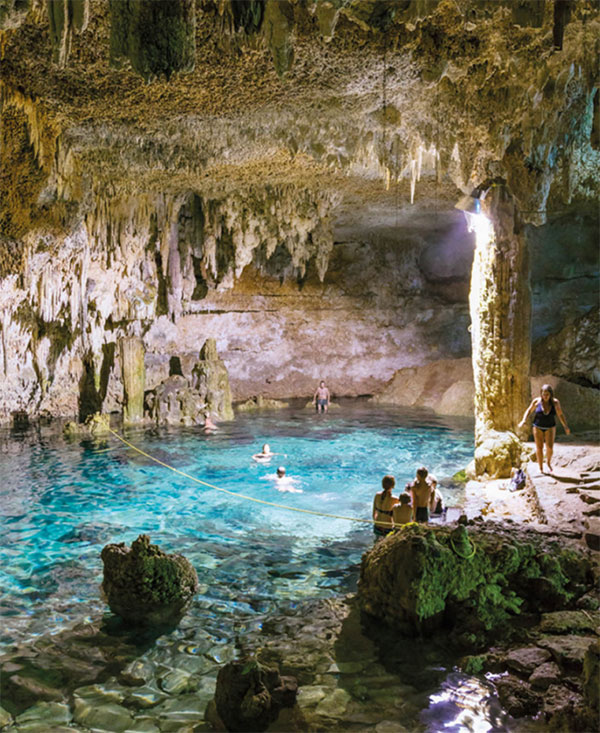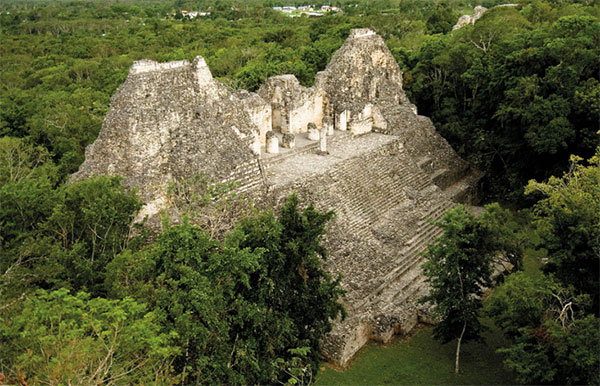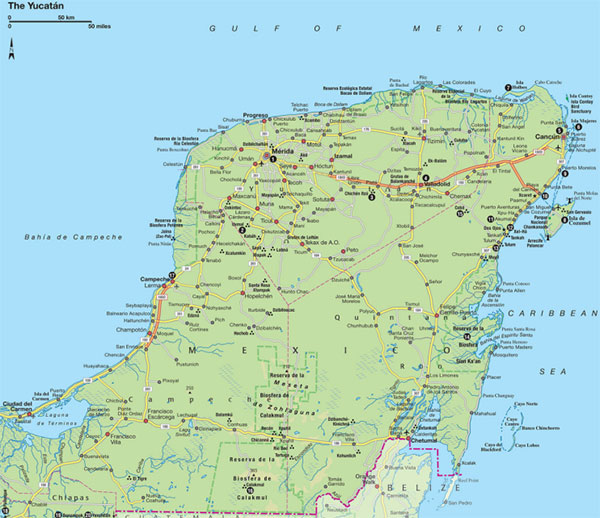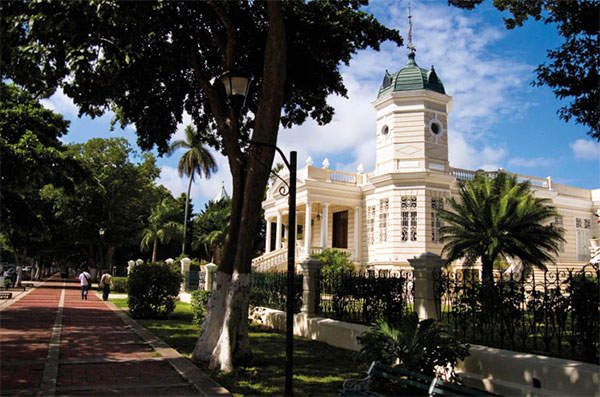SOUTHERN MEXICO
The Yucatán Peninsula contains a wealth of cultural and ecological treasures, not least the Mayan archeological wonders and cave systems – and, of course, miles of beautiful beaches.
Main Attractions
Mérida
Chichén Itzá
Cancún
Cozumel
Playa del Carmen
Tulum
Sian Ka’an
Palenque
San Cristóbal de las Casas
With seemingly endless sunshine enhancing fascinating ancient cultural sites and resorts of every type, the southern states of Mexico are well known as a major tourist destination. Visitors to the Yucatán Peninsula spend their time clambering over awe-inspiring ruins; sunning themselves on golden beaches; discovering the natural splendors of the environment; and exploring old colonial towns, all supported by a cohesive and well-established tourism infrastructure.

Cenote Choo-Ha near Cobá, Yucatán.
AWL Images Ltd
Everything began to change in the region in the 1970s and development has been accelerating ever since. The Mexican government decided on tourism as a foreign currency earner, and chose the beaches of the eastern Yucatán, especially the near-deserted island of Cancún, as ideal sites for development. Since then, Cancún has become a major world resort, and the once-remote beaches to the south have been dubbed the Riviera Maya.
For those seeking an insight into the Maya, ruins can be found all over the peninsula, many only partially excavated, or even buried in the forest. No visit is complete without a look at Chichén Itzá, perhaps the most famous ruin in the Maya world. Despite the crowds, its Castillo temple, sacred cenote sacrificial pool, and group of a Thousand Columns are still inspirational, unforgettable sights. Edzná has a remarkable five-story temple. Tulum, a minor site in every sense, has an incomparable location, framed with white-sand Caribbean beaches and turquoise waters. In the far south are the remains of Calakmul, one of the two superpowers of the Classic Maya era (along with Tikal). Aside from Mayan ruins, there’s the colonial charm in the majestic core of Mérida and the pastel-painted buildings of Campeche. Few of the henequen plantations that once brought great wealth to Yucatán landowners are still operating today, though some have been resurrected as luxury rural hotels.

The ruins of Becán.
Alex Havret/Apa Publications

Famously, the Yucatán’s Caribbean coastline is stunning. The white beaches and azure waters between Cancún and Tulum attract the most visitors, and there are many delightful beaches and lagoons down this way, such as Akumal and Tankah. Offshore is the island of Cozumel, its coral walls the talk of dive magazines the world over, and the more intimate beaches of tiny Isla Mujeres. National parks and preserves are extensive and varied. Most impressive is the Calakmul Biosphere Reserve with its pristine jungle and wildlife. The Sian Ka’an Biosphere Reserve is another vast protected territory, whose boundaries also include the offshore reef. The Río Lagartos and Celestún wetlands are superb for birders, especially for the flocks of flamingos. Finally, there are hundreds of atmospheric cenotes across the Yucatán to swim in: a must-do experience for any visitor.
The Yucatán Maya
Yet, not far from the tourist resorts, many Yucatán Maya live in much the same way as they have for centuries. There are almost half a million Maya in the region, most of whom speak Yucatec Maya. In more remote areas, many still own and farm the land communally. They cultivate maize, chili peppers, and beans as they have always done, and most families have beehives for the Yucatán’s celebrated honey. Nevertheless, the Maya still struggle to survive. Traditional farming gives only a meager income. The tourism boom has, naturally, provided new kinds of work; newer tourist towns like Playa del Carmen are full of Yucatecan migrants, and many Maya spend a few months each year on the coast, working in construction or hotels, before returning home with their savings.
The more fluid political situation in Mexico since the ending of the one-party rule of the PRI in 2000 has made it a little easier for village people to be heard, but the Maya’s right to own and farm land is still constantly threatened by development. Maya cultural traditions are often seen only as a picturesque part of the tourist industry. Although they are the most Mexican of Mexico’s inhabitants, they are still often excluded socially and treated as outcasts in their own land. In Chiapas, conflicts have been more intense, and led to the revolt by the Zapatista National Liberation Army (EZLN) in 1994, when, as so often in the past, the Maya emerged from remote jungle areas and took over towns to press their claims for more land and other social demands. Today, all is calm though solutions remain to be found.
The northern Yucatan
The northern section of the Yucatán Peninsula is occupied largely by the wedge-shaped state of Yucatán. The landscape up here is flat, dry, and covered in scrub bush. The sacred cenotes of the Maya (deep natural wells in the limestone crust) provided the only access to fresh water. Second to the peninsula’s Caribbean beach resorts, this is the region that draws the most visitors for its sheer quantity of superb archeological sites, crowned by the magnificent Chichén Itzá and Uxmal, and for the special charm of the Yucatecan way of life.
The ideal base for exploring the Yucatán is its elegant colonial capital, Mérida 1 [map] . Formerly the home of millionaires who made their riches during the henequen heyday, today this thriving city is visited by more than 2 million people annually.
In spite of this year-round human traffic, Mérida remains a pleasant city. Once enclosed by walls, Mérida’s downtown area is compact, its narrow streets and closely packed buildings originally laid out in the era of the horse and buggy, and now filled by motor traffic. It operates on a grid plan with numbered streets: even numbers run north–south, odd numbers east–west.
Around the Plaza Mayor
At the heart of the city center, the wonderfully shady Plaza Mayor is bound by calles 61 and 63, and 60 and 62. On its northern side, the Pasaje Picheta leads to an internal plaza with café tables under a glass roof. Across on the south side of the laurel-shaded plaza is the Casa de Montejo, built in 1549 for the first Spanish governor of the Yucatán, Francisco de Montejo. It has been partially rebuilt as a bank, but still retains its extraordinary Renaissance portico, with carvings of armed warriors standing on screaming heads.

Around Plaza Mayor in Mérida.
Alex Havret/Apa Publications
The Maya name for the city on the site, Tihó, means ‘the Place of the Five Temples.’ Many of their stones were used to erect the Catedral de San Ildefonso, diagonally opposite the Montejo mansion on the northeast corner. Built from 1562 to 1598, this was only the second cathedral built anywhere in the Americas, after Santo Domingo in the Dominican Republic. Next to the cathedral, housed in the former archbishop’s palace, is the Museo de Arte Contemporáneo de Yucatán or MACAY (www.macay.org; Mon-Tue & Thu-Sat 10am–2pm; free), Mérida’s major modern art museum, containing an important collection of works from local and national artists.
On the plaza’s northern side is the Palacio del Gobierno (Governor’s Palace), built in 1892, on whose murals Fernando Castro Pacheco worked for 25 years. The restored Teatro Mérida, in an Art Deco building around the corner on Calle 62, has a bar and a movie theater. The west side of the square is dominated by the Ayuntamiento or city hall, with an elegant 18th-century colonnaded facade. Next to it, the corner of Calle 61 is now occupied by the Centro Cultural de Olimpo (10am-2pm Mon-Sat & 10am-5pm Sun, shows outside of these hours), an attractive modern cultural center, with a planetarium.
Calle 60 and around
Running across the east side of the Plaza Mayor in front of the cathedral, Calle 60 is Mérida’s traditional main street, and you will find many sights on and just off this thoroughfare. East of Calle 60 is the the giant Mercado on Calle 65, where shops and stalls sell products ranging from traditional hammocks, panama hats, and embroidery to electronics and giant cooking pots. At the corner of calles 65 and 56, the former post office is now the Museo de la Ciudad (tel: 999 924 4264; Tue–Fri 9am–6pm, Sat 9am–2pm; free).
One block north of the cathedral, the Parque Hidalgo is dominated by the Jesuit-built church of La Tercera Orden, completed in 1618 and containing a painting that depicts the meeting in 1542 of Montejo and Tutul Xiú, the first Maya ruler to convert to Christianity. The sparsely equipped tourist office (daily 8am–8pm) is in the domed Teatro Peón Contreras (built in 1900), with an ornate marble staircase designed by the Italian architect Enrico Deserti, who was also responsible for the city’s Anthropology Museum. Opposite the theater stands the University of Yucatán.